Abstract
This article is devoted to the structure and contents of the distance education module “The evaluation of the teacher’s preparedness towards implementation of interdisciplinary connections” The module is intended for the teachers of geography and allied disciplines who are interested in this issue. Aim of the module. The module is designed to create an environment for solving professional issues, and to indulge individual professional interests of the participants. Tasks. The task of the module is to enhance the learning and professional activities of the participants; facilitate the implementation of individual educational route; reveal the teacher’s preparedness towards establishing interdisciplinary connections. Methods. We took the activity-based competency approach using informational technology. Results. We revealed the pedagogical aspect of the integration and didactic function of the integration. Also, we outlined the role of integration in applying competency approach, in building creative capabilities of the participants of educational process and in organization of efficient learning activity.
Keywords: Distance education moduleinterdisciplinary connectionsintegrationintegrative approachinterdisciplinary problem-based situationskills upgrading
Introduction
Rationale for the study
The main objective of Russian educational policy is to comply with modern demands for education quality which meets the international requirements of an individual, society and state while preserving its fundamentality.
Russia is a participant of UNESCO “XXI century open educational system” educational program. Its main priority is to develop an integrative scientific worldview and world perception. Worldview impact of interdisciplinary connections (IDC) involves revealing the unity of all that exists, relations between the forms of motion, the unity of animate and inanimate nature, its motion and development.
A teacher who possesses the 1st qualification grade knows the fundamental components of his/her main subject and allied disciplines perfectly.
Speaking of productive and reproductive activities, the integrative activity is mainly connected with productive one, which is essentially creating new information.
As a rule, the teachers in the Republic of Tatarstan have double specialty and qualify as geography/ biology/chemistry teachers.
The module includes lectures on psychological and pedagogical aspects of academic subjects integration, main requirements for integrative environment organization and teaching activities using integration principle. The main concepts: integrative approach, interdisciplinary problem-based situation, integration.
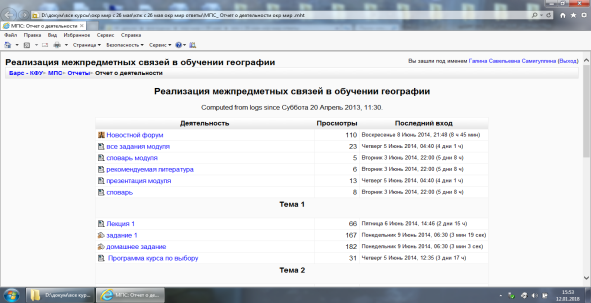
Problem Statement
The results of the Unified State Examination in biology, geography and physics show that the students have difficulties in determining the order of objects, processes or phenomena, for example, when explaining the causes of the increased greenhouse effect. The Unified State Examination scores show a decline and the reason is that the examination tasks are aimed at testing the students’ ability to apply metadisciplinary knowledge, to use the information they learned in one field for solving problems in other areas of knowledge. However, educational standards do not include interdisciplinary connections and integration of subjects. The learning is based on mechanistic analysis of the constituent parts of the world and preservice teachers are not taught to integrate their knowledge, because the final goal of Teacher Education is training of a teacher who is highly skilled in one subject.
According to our experience in advanced teacher training, pedagogical creativity is closely connected with implementation of interdisciplinary connections and integration. MOODLE remote module allows solving a range of professional problems (Hutchison & Colwell, 2016; Kumar & Sharma, 2016). Methodological, organizational and planning activity of a teacher aimed at implementation of integration principle is justified with a necessity to develop ability to identify the essentials and infer cause-and-effect relationships. Integration allows reinterpreting, analyzing and correcting the existing data. The teacher introduces concepts and interdisciplinary methods common for all nature sciences, teaches the students to use methods of scientific cognition learned in one field to solve problems in the other one, and the material is introduces in all levels of difficulty. The teacher organizes activities during integration class in the way that allows the students to go beyond the scope of the curriculum.
Research Questions
How can we upgrade the teachers’ interdisciplinary skills and prepare them for integrative teaching using distant education module MOODLE?
Purpose of the Study
The purpose of our study is to outline the structure and content of MOODLE remote module and its role in teacher proficiency enhancement, building creative capabilities of the participants of educational process and in organization of efficient learning activity.
Research Methods
The remote module content is based on integrative approach, holistic view and interrelation of all educational components (objective, content, methods, forms, media). Integration is aimed at making use of information, methods and tools of several sciences.
The activity-based competency approach that we took aims at complying with modern demands for education quality while preserving its fundamentality, developing an integrative scientific worldview, organizing productive educational activity and enhancing the learning and professional activities of the teachers.
This method is implemented through the example of the interdisciplinary connections between geography and physics in the context of problem-based situation (Visser, Coenders, Terlouw, & Pieters, 2010). Integration assumes using several common points: forms of scientific cognition (problem, hypothesis, idea, category, law, theory); methods of scientific cognition and principles of scientific thinking (analysis, synthesis, comparison, generalization, induction, deduction); empirical methods of research (observation, measurement, experiment, intuition); theoretical methods of research (analogy, idealization, formalization). Integrative approach implies holistic view and interrelation of all educational components (objective, content, methods, forms, media).
Findings
The results of the Unified State Examination in biology, geography and physics show that the students have difficulties in determining the order of objects, processes or phenomena, for example, when explaining the causes of the increased greenhouse effect. The Unified State Examination scores show a decline and the reason is that the examination tasks are aimed at testing the students’ ability to apply metadisciplinary knowledge, to use the information they learned in one field for solving problems in other areas of knowledge. The analysis of the teaching materials proved that learning is based on mechanistic analysis of the constituent parts of the world.
The analysis of the tasks intended for IDC revealed the following drawbacks:
Some problems are impracticable, for example: how many wagons of coal will it take to melt the ice of Ladoga Lake?
There are no tasks for practicing skills acquired in the course of studying other subjects.
There are no tasks that go beyond the scope of one subject.
There are no tasks dealing with technical and industrial problems.
There are no tasks requiring conversion between different semiotic systems.
Physical knowledge forms the basis of geography and biology. Theme 3 of the remote module “The evaluation of the teacher’s preparedness towards implementation of interdisciplinary connections” is devoted to the physics of natural objects (Figure
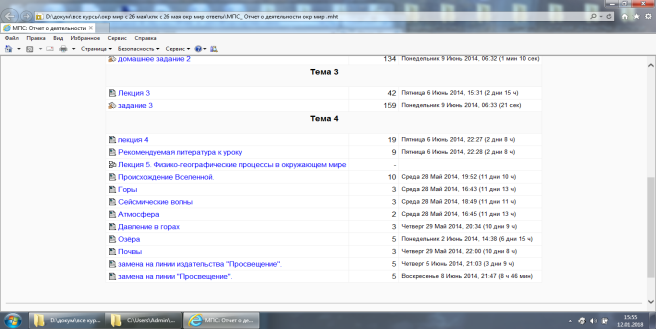
However, educational standards do not include interdisciplinary connections and integration of subjects. According to our experience in advanced teacher training, pedagogical creativity is closely connected with implementation of IDC and integration. The remote module allows solving a range of professional problems (Hutchison & Colwell, 2016; Kumar & Sharma, 2016). The module includes lectures on psychological and pedagogical aspects of subjects integration, general requirements for integrative teaching organization, integration principle in pedagogical and professional activity of a teacher. Learning activities are connected with the diagnostic tool developed by Elagina (2014): the development of challenges, plans of observation, experiments, phenomenon study, quantitative tasks, qualitative tasks.
Interdisciplinary problem-based situations
There are two types of activity: reproductive and variable. Reproductive activity implies rearranging, reproducing facts, concepts and work methods; variable one assumes transfer of knowledge between different areas. Reproductive activity is characterized mainly by following fixed algorithms and strict rules in familiar environment. Integrative activity is connected with productive one, which is essentially creating new or subjectively new information [1]. Productive activity assumes using acquired information in new situations. Interdisciplinary problem-based situation is a perfect example of productive activity. Interdisciplinary problem-based situation is created deliberately by the teacher and means a condition of intellectual difficulty. This condition emerges when a student finds out that the information they possess is insufficient for solving the problem and recognizes the importance of interdisciplinary integration.
Interdisciplinary problem-based situations are caused by unexpected cases, conflicts (contradictions), denials, indefiniteness (the required data is missing or redundant). The first lecture introduces course participants to psychological and pedagogical aspects of integration. The second lecture presents the scheme for integrated forms of learning organization in and out of class: tasks, challenges, observations, experiments, phenomena studies. A series of assignments is aimed at development of tasks set, including: typing of tasks and possibility of skills transfer between different domains; typing of tasks and assignments according to the type of intellectual activity (training of analytical skills, design skills and others) and according to the peculiarities of the tasks conditions; complex tasks: pervasive (throughout the course), complex (several disciplines are used simultaneously), complex and target-oriented (one theme is developed through several disciplines). The plan of experiments is introduced through the example of soil acidity estimation and the obtained data is analyzed. The final conclusion of soil acidity level was given using the method of bioindication with the help of interdisciplinary connections.
Tasks examples
The qualitative tasks based on an actual real-life situation were worked out: “A student ate a bread-and-butter (100 g of bread + 20 g of butter) and obtained 1600000 joules. How high above the ground could he climb using the energy of the butter-and-bread if his organism converted all the energy of the butter-and-bread into muscular energy? The weight of the student is 40 kg.” (the 1st level of difficulty). The 1 level of difficulty task is solved as follows: a) identify and write down the known quantities; b) identify the unknown quantity; c) state formulae required for solution; d) explain all the formulae required for solution; e) make correct calculations; f) write down the result based on approximate calculations; g) verify the solution i) write down the final result.
The following quantitative task with the solution algorithm (the 11th level of difficulty) is based on a short story by A.P.Chekhov “On perishableness”. The course participants have to read a story about Semyon Petrovich Podtykin, whose medical condition was caused by his voracity and then explain this fact, build a logical line of reasoning using deduction and suggest a hypothesis of the task.
These quantitative and qualitative tasks serve as an example of conversion of information between different semiotic systems.
The following graphics task is also solved with the same algorithm (identify correct values of quantities located on a coordinate grid, choose a unit segment on the axes, explain the meaning of intersection points coordinates) and uses wind rose as an example. The student must analyze the wind rose, identify the highland region and draw the direction of ridges [Figure

Scheme 4 displays a conventional border that divides the bottom of the Caspian Sea. Use your knowledge of physics to explain why this partition is unsuitable. Annotate the names of the countries.
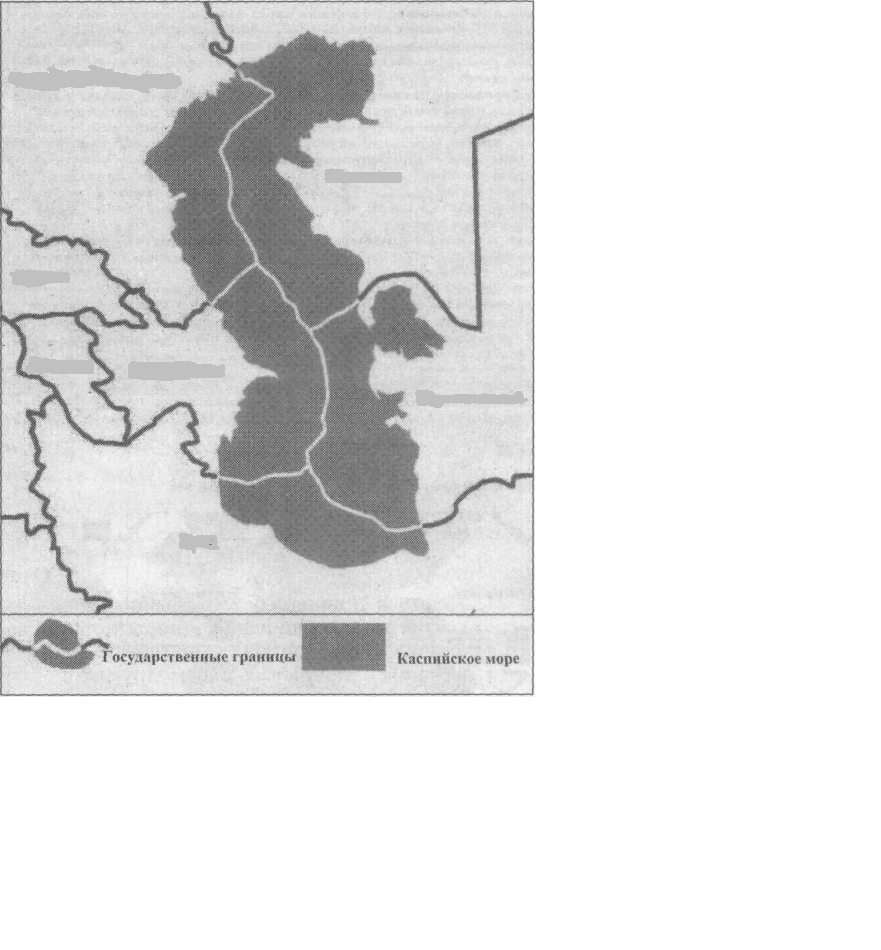
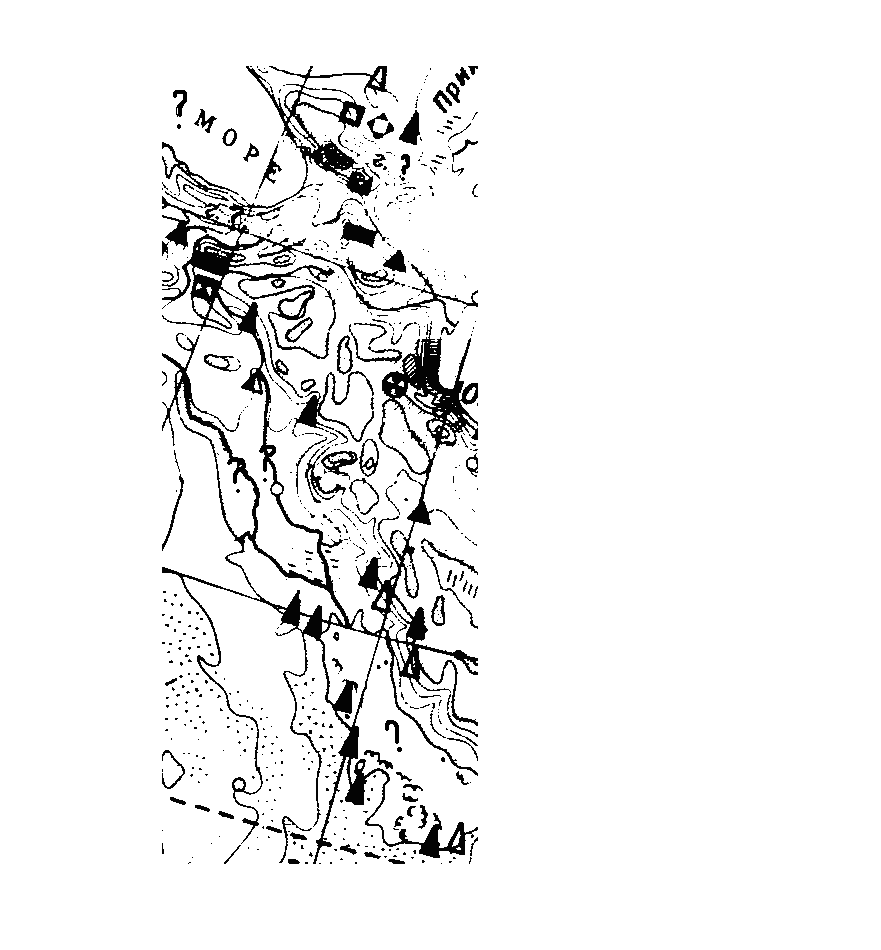
The task: use figure
Implementation of integrity principle
Implementation of integrity principle should consider problems of information overload in modern education. The amount of knowledge and skills to be learned remains the same and the teaching period required for it reduces, which often results in emotional and physical burnout syndrome [5].
There are two possibilities for integration. The first one is merging the content of different disciplines, and the second one, which is interesting and highly charged, is the integration of “knowledge and mind”, applying the knowledge the student received in one field to solve the problems in other domains.
Methodological, organizational and planning activity of a teacher aimed at implementation of integration principle is justified with a necessity to develop ability to identify the essentials and infer cause-and-effect relationships.
For example, physics educational standards include acquisition of generalized methods of scientific cognition by the students. Systematization of theoretical knowledge is advantageous for review of the learned material. Generalization and systematization of the knowledge is one of the unsolved methodological problems in teaching geography, biology, physics and chemistry.
During the lessons dedicated to generalization and systematization the acquired knowledge is reviewed on a whole new level and the knowledge and methods of intellectual activity are transferred to new situations. M.V. Kovalevskaya claims that generalization and reviewing is only possible when at least two objects, concepts, principles or methods are compared. A.Ya. Danilyuk justly notes that it is not content that is integrated, it is knowledge and mind. Integration allows reinterpreting, analyzing and correcting the existing data. The teacher introduces concepts and interdisciplinary methods common for all nature sciences, teaches the students to use methods of scientific cognition learned in one field to solve problems in the other one, and the material is introduces in all levels of difficulty. The teacher organizes activities during integration class in the way that allows the students to go beyond the scope of the curriculum. The practical session of analysis and self-analysis of integrative lessons allows to test the teacher’s ability: to define the type of the lesson and find a proper place for it in the curriculum; to set a three-pronged learning goal (TLG); develop the structure and content of a lesson according to TLG etc. Participants must evaluate teaching materials of the allied discipline and fill in an evaluation checklist as their home assignment.
Instructions and MEAs educational programs on physics, geography.
A set of textbooks (and related materials on the subject).
Course and case planning with an indication of IDC.
The development of lesson plans.
Manuals, recommendations and cards for geography and physics teachers.
The availability of learning material aimed at the implementation of IDC.
The availability of visual aids with interdisciplinary content.
The availability of reference and additional literature.
Package availability of criterion-oriented tests, assignments for submission, etc. to check IDC implementation level.
Despite the lack of IDC in programs and qualification requirements, the teachers expressed their interest in given problem (Figure
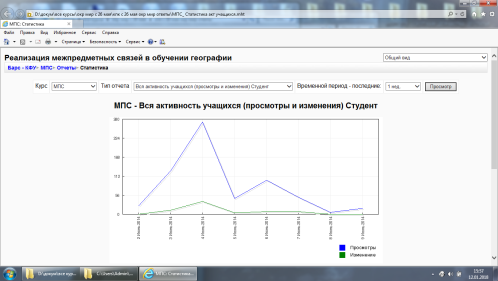
Conclusion
During the research we defined the following body of general pedagogical and special professional skills and knowledge that a teacher must possess to implement interdisciplinary connections: a) technology for selecting events, facts and phenomena to be integrated in geography and allied disciplines; b) ability to identify professional difficulties of a teacher in their attempts to integrate geography and allied disciplines; c) ability to make adjustments to the structure and content of geography curriculum; d) ability to develop guidelines for integration of geography, physics, biology, chemistry etc.
There are several reasons of the teachers' ill-preparedness for integration. First of all, preservice teachers are not taught to integrate their knowledge, because the final goal of Teacher Education is training of a teacher who is highly skilled in one subject. Metadisciplinary knowledge of the older generation of teachers is degrading and there is no call for the creative integrative activity in this field. Also the professional teacher activity is inconsistent with the strategy of integration and fundamentalization.
The exploration of integration issues is connected with adoption of cost-efficient technologies and development of integrative scientific view. The fundamentality and unity of natural sciences education and teacher proficiency enhancement can be achieved through adjustments in methodology and content of education, emphasis on the study of fundamental laws of the universe and shift from pragmatic, subject-oriented knowledge to development of scientific thinking and scientific knowledge.
Acknowledgments
This research was published in monograph and other works of the author (Coenders & Terlouw, 2015; Hutchison & Colwell, 2016). The work “The technologies for developing and implementing complex integrated tasks” took first place and was awarded with a diploma at the International educational contest of professional skills “Educational technologies as an object of pedagogical choice”, in nomination of “Extended education”.
References
- Coenders, F., & Terlouw, C. (2015). A Model for In-service Teacher Learning in the Context of an Innovation. Journal of science teacher education, 26(5), 451-470.
- Elagina, V. S. (2014). Developing student teachers’ pedagogical competency. Modern research-based approaches, 10, 113-115.
- Hutchison, A., & Colwell, J. (2016). Preservice Teachers' Use of the Technology Integration Planning Cycle to Integrate iPads Into Literacy Instruction. Journal of Research on Technology in Education, 48(1), 1-15.
- Kumar, V., & Sharma, D. (2016). Creating Collaborative and Convenient Learning Environment Using Cloud-Based Moodle LMS: An Instructor and Administrator Perspective. International Journal of Web-Based Learning and Teaching Technologies (IJWLTT), 11(1), 35-50.
- Visser, T. C., Coenders, F. G., Terlouw, C., & Pieters, J. M. (2010). Essential characteristics for a professional development program for promoting the implementation of a multidisciplinary science module. Journal of science teacher education, 21(6), 623-642.
Copyright information

This work is licensed under a Creative Commons Attribution-NonCommercial-NoDerivatives 4.0 International License.
About this article
Publication Date
05 September 2018
Article Doi
eBook ISBN
978-1-80296-044-0
Publisher
Future Academy
Volume
45
Print ISBN (optional)
-
Edition Number
1st Edition
Pages
1-993
Subjects
Teacher training, teacher, teaching skills, teaching techniques
Cite this article as:
Samigullina, G. S. (2018). Using Moodle To Upgrade Skills Of Teachers Of Geography And Allied Disciplines. In R. Valeeva (Ed.), Teacher Education - IFTE 2018, vol 45. European Proceedings of Social and Behavioural Sciences (pp. 367-375). Future Academy. https://doi.org/10.15405/epsbs.2018.09.42

